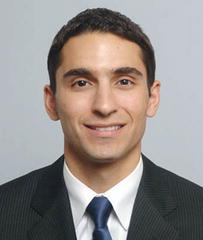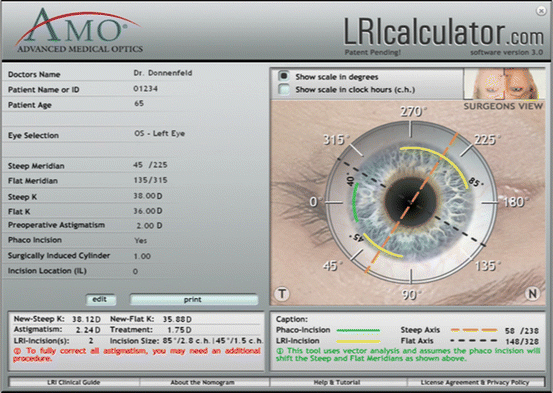practices comprehensive ophthalmologist with Betz Ophthalmology Associates in Lewisburg, Pennsylvania. His areas of interest include refractive-cataract surgery and anterior segment reconstruction. He recently completed his ophthalmology residency at Nassau University Medical Center, East Meadow, NY. He earned his Doctor of Medicine at Thomas Jefferson University, Philadelphia, PA after transferring from International Medical University, Malaysia, where he was awarded the prestigious Dr. Saidi Hashim Memorial Gold Medal for Academic Excellence.


completed his residency at Nassau University Medical Center and a fellowship in cornea, refractive, and cataract surgery with Drs. Henry Perry and Eric Donnenfeld. He is now in private practice in southern California.


is a founding partner of Ophthalmic Consultants of Long Island and Connecticut, immediate past president of ASCRS and is a trustee of Dartmouth Medical School and a clinical professor of ophthalmology at NYU. He has written over 180 peer review papers on cornea, external disease, cataract and refractive surgery, and 25 book chapters and books.


9.1 Introduction
The introduction of femtosecond lasers has revolutionized cataract surgery, further propelling modern cataract surgery into refractive surgery. This chapter will discuss the use of femtosecond laser for management of corneal astigmatism in cataract surgery.
9.1.1 Modern Cataract Surgery
Recent advancements have allowed surgeons to perform cataract surgery quickly, safely, and with great visual results on a consistent basis. As a result, it has become a refractive procedure in which patients have increasingly high expectations for both functional visual improvement as well as spectacle independence [1, 2]. The single most important aspect of the ability to provide good surgical outcomes, quality of vision, and satisfaction for patients requesting refractive cataract surgery and optimal postoperative uncorrected visual acuity is management of astigmatism.
9.2 Astigmatism Management in the Modern Era
Astigmatism is an optical phenomenon in which incoming light rays are focused at more than one location: anterior, posterior, or directly on the retina. This causes visual distortion and decreased visual acuity. The two main sources of astigmatism are the cornea and the lens. When performing cataract surgery, it is important to neutralize corneal astigmatism that may be preexisting or surgically induced. Residual astigmatism of 0.50 diopters (D) or even less may result in glare, symptomatic blur, ghosting, and halos [3]. As a result, greater emphasis has been placed on treating corneal astigmatism at the time of cataract surgery. A recent study of 4,540 eyes of 2,415 patients showed that corneal astigmatism is present in the majority of patients undergoing cataract surgery, with at least 1.50 D measured in 22.2 % of study eyes [4]. Approximately 38 % of eyes undergoing cataract surgery have at least 1.00 D of preexisting corneal astigmatism, and 72 % of patients have 0.5 D or more [5].
9.2.1 Corneal Astigmatism and Multifocal IOLs
Patients implanted with multifocal IOLs are significantly more sensitive to small spherical and cylindrical irregularities in the cornea than those receiving traditional monofocal IOLs. Therefore, surgeons who implant refractive IOLs must be prepared to sufficiently reduce corneal astigmatism in order to achieve satisfactory results.
9.2.2 The Coupling Effect of Corneal Astigmatic Incisions
Corneal incisions used to correct visually significant astigmatism are deemed “astigmatic incisions.” When placed circumferentially at the steep corneal meridian, they cause corneal flattening at that axis while inducing steepening at the meridian 90° away. The ratio of flattening at the meridian of incision to induced steepening at the opposite meridian is known as the coupling ratio. Various factors, including length, depth, and position of the incisions, may influence this ratio. Long, straight, and tangential incisions tend to induce a positive coupling ratio (greater than 1.0), causing a hyperopic shift. A coupling ratio of 1 is ideal because the spherical equivalent remains constant. Smaller, standardized arcuate incisions are more likely to yield coupling ratios closest to 1 [6].
9.2.3 Types of Corneal Astigmatic Incisions
Two variations of astigmatic incisions are regularly used today: peripheral corneal relaxing incision (PCRI) (traditionally referred to as “limbal relaxing incisions” although they are made in the peripheral cornea and not the limbus) and astigmatic arcuate keratotomy (AK). Astigmatic transverse keratotomy (TK) was frequently used in the past in combination with astigmatic radial keratotomy (RK) to correct myopic astigmatism, but both are largely obsolete. Arcuate keratotomy was also used to correct natural corneal astigmatism, but is now used primarily to correct post-keratoplasty astigmatism. PCRIs are the mainstay treatment today to manage astigmatism during or after phacoemulsification and IOL implantation.
AKs (curved incisions) and TKs (straight incisions) are typically placed in the cornea at the 7 mm optical zone, closer to the visual axis and at greater depth (90 %) compared to PCRIs which are partial thickness incisions placed immediately anterior to the limbus. PCRIs are set at approximately 600 μm depth or 50 μm less than the thinnest pachymetry at the limbus. PCRIs are performed more frequently due to several important advantages. These advantages include a reduced tendency to cause axial shift, less irregular astigmatism, a 1:1 coupling ratio, a decreased chance of visually significant scarring, and a reduced likelihood of perforation [7].
9.2.4 Preoperative Planning for Limbal Relaxing Incisions
Preparation for a PCRI first involves ascertaining the steep corneal meridian at which the incision will be made. The incision length and depth are then calculated based on the magnitude of astigmatism to be corrected. If needed, numerous PCRI nomograms are available. There are a number of PCRI nomograms for correcting small amounts of cylinder and many studies evaluating the efficacy of PCRIs that have been performed [8–19]. In one study on the effectiveness of PCRIs, there was a 60 % average reduction of cylinder [20], with 79 % of patients corrected to less than 1.00 D of cylinder and 59 % corrected to less than 0.5 D of cylinder. The 60 % reduction in cylinder compares favorably with the results achieved using toric IOLs, which result in a mean 58.4 % reduction in cylinder [21].
Many nomograms are adjusted for age and cylinder axis, making them detailed and complex and giving the impression that the procedure is extremely precise and unforgiving. In our opinion, however, this simply is not the case. The PCRI procedure has numerous chances for error, and the many variables that help determine how the incision is performed can each be measured incorrectly. The incision itself, if performed manually, is only as precise as the surgeon making the incision and the accuracy of the blade. Any of these errors can compound and result in suboptimal visual acuity.
In addition, the astigmatism induced by the phacoemulsification incision must be considered when determining the final postoperative residual cylinder that is to be treated. For example, a superior clear corneal incision flattens the incised meridian resulting in additional against-the-rule astigmatism. In a patient with 0.5 D of against-the-rule astigmatism, it would be appropriate to perform a PCRI at 180° preoperatively. Conversely, in a patient with 0.5 D of preexisting with-the-rule astigmatism, a PCRI can be avoided altogether by simply placing the clear corneal incision superiorly. Oblique astigmatism is more complex and requires a vector analysis [16, 22].
Vector analysis allows the surgeon to determine the proper meridian at which to perform an astigmatic incision based on the preoperative astigmatism and clear corneal incision. All of these factors can be calculated online at www.PCRIcalculator.com (Fig. 9.1). This calculator uses vector analysis to calculate where to make PCRI incisions based on preoperative patient keratometry and the surgeon’s induced astigmatism; it also uses the Donnenfeld and Nichamin nomogram and provides a visual map of the meridian and length of incisions that should be performed. A printout of the PCRI calculator can be brought to the operating room and used as a guide when marking the cornea and performing PCRIs.


Fig. 9.1
The Donnenfeld and Nichamin nomogram is available on the Internet at www.LRIcalculator.com
9.2.5 Management of Potential Complications with Limbal Relaxing Incisions
As with any surgical procedure, there are potential complications associated with PCRIs. Most, however, are either temporary or correctable. Potential problems include overcorrection, undercorrection, infection, perforation of the cornea, decreased corneal sensation, dry eye disease, induced irregular astigmatism, and discomfort. The procedure is generally not associated with glare or starbursts, as may be seen with radial keratotomy or arcuate keratotomy. For undercorrected patients with significant residual astigmatism, it may be necessary to redeepen or extend the PCRI. For large overcorrections, we recommend waiting and then later cleaning out the wound with a Sinskey hook and suturing it with 10-0 nylon if necessary. For smaller overcorrections, an excimer laser photoablation may be employed. We rarely recommend placing additional PCRIs in the meridian 90° away from the original PCRIs for consecutive cylinder, as this may induce irregular astigmatism. In the event of corneal perforation, a suture may need to be placed if the wound does not self seal.
Suboptimal accuracy and potential complications may be the reason why the majority of cataract surgeons choose not to perform manual astigmatic incisions. In a survey of 233 surgeons, only 73 routinely performed PCRIs [23]. Alternative procedures for managing astigmatism exist including excimer laser photoablation, toric IOL implantation, and conductive keratoplasty. These options, however, may not be available to all cataract surgeons and their patients. In addition, toric multifocal IOLs are currently not available in the United States.
9.2.6 Manually Performed Limbal Relaxing Incisions: The Pros and Cons
Performing PCRIs is a necessary step in the path to becoming a good refractive cataract surgeon. They allow the surgeon the opportunity to treat small residual refractive errors. Manual PCRIs are easy to perform, inexpensive, and repeatable; may be performed at the time of cataract surgery; provide rapid visual recovery; and do not preclude future excimer laser treatments. However, there is a variable and unpredictable treatment response due to imprecise depth, length, angulation, and position of the incisions. This causes a shift in the coupling ratio away from 1 resulting in an incomplete correction of astigmatism as well as a change in spherical equivalent. These concerns combined with surgeon variability make manual PCRIs more of an art form than a science.
An alternative to manual astigmatic incisions is femtosecond laser-guided astigmatic correction.
9.3 Femtosecond Lasers in Ophthalmology
Femtosecond lasers for ophthalmic surgery have been commercially available since 1999, and more than four million procedures have been performed for the creation of LASIK flaps, lamellar and penetrating keratoplasties, and DSEK [24–29]. Attention has shifted towards femtosecond laser-guided procedures because they offer a greater degree of precision, accuracy, and reproducibility than manual methods [30].
The US Food and Drug Administration have approved 510(k) clearance for the use of several femtosecond lasers for clinical applications in cataract surgery. The most remarkable features of laser cataract surgery include the precision of the performed incisions with minimal collateral damage to surrounding tissues, accuracy of capsulotomy dimensions and diameters, enhancement of capsular edge strength, reduction of phaco power in lens fragmentation, and improved wound sealing and healing, all of which lead to better and more reproducible results compared with manual, mechanical surgeries. The treatment of astigmatism during cataract surgery with femtosecond laser astigmatic incisions is positioned to revolutionize refractive cataract surgery.
9.3.1 Femtosecond Lasers: Basic Principles
Femtosecond lasers are infrared photodisruptive lasers that generate a sequence of adjacent cavitation gas bubbles precisely focused on the target tissue. The short pulse durations of less than 800 femtoseconds (1 femtosecond in 10−15 s) directly translate into a reduction in energy utilization when compared to previous ophthalmic lasers. Per-pulse energies can be reduced 1,000-fold from around 1−10 mJ for nanosecond lasers to 1−10 μJ for femtosecond lasers. These reductions in per-pulse energy result in substantial reductions in collateral tissue damage, shifting from a few millimeters from the intended target for nanosecond lasers to just a few microns for femtosecond lasers. Similar to the Nd:YAG laser systems, femtosecond laser pulses pass through transparent tissues and can be focused at a predetermined depth [31].
9.3.2 Femtosecond Laser-Assisted Corneal Arcuate Incisions: The Benefits
A major clinical application of the femtosecond laser is in creating corneal arcuate incisions. It allows for precise and repeatable incisions, which are necessary for consistent results not normally achieved through manual methods [32]. In a case study, femtosecond laser arcuate keratotomy was used to correct astigmatism. The refraction of the patients’ eyes was measured along with the corneal thickness. Then the keratometry parameters were evaluated, and the femtosecond laser created the incisions, the length and position of which were calculated individually, per eye. OCT-controlled corneal pachymetry was performed directly in the area of the intended incisions and then programmed into the laser, which allows for extremely high levels of precision. The study results showed that with the femtosecond laser, astigmatism could be better corrected with an improved best-corrected visual acuity than was predicted in the preoperative values. Furthermore, the depth and location of the incisions were consistent with the surgical plan. Laser technology is able to create uniform corneal incisions precisely and predictably [33].
Stay updated, free articles. Join our Telegram channel

Full access? Get Clinical Tree


